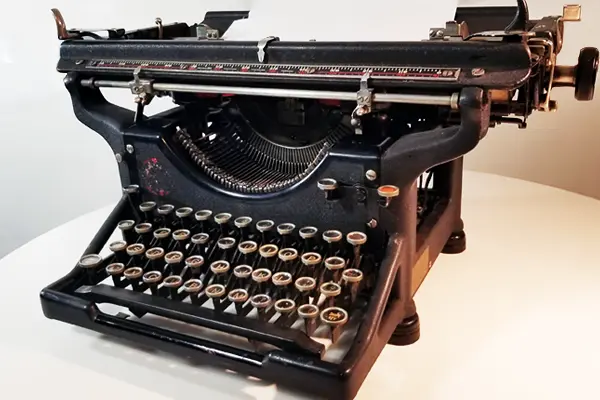The Back Story
I’ve been slowly working away at fixing my grandfather’s typewriter (just like everyone). It’s an Underwood № 5, built in 1914. The same year WWI started. Somewhere around the time of WWII, it was ‘refurbished’ to add a wider carriage, presumably to allow for wider paper. My repair would have been easier had I not previously tried to fix the carriage return [1] mechanism in my early teens (also a long time ago). Never having apprenticed with a traditional Swiss watchmaker, this typewriter is the most complicated piece of mechanical engineering I’ve ever seen. So when I took it apart as a boy of a certain age, I promptly decided I couldn’t fix it, lost interest in the project and then lost the bag of parts I had removed.
Recently, I was recalling my early days in marketing, when you would see vintage typewriters as curiosity pieces in ad agency creative departments and copywriters’ offices. I never understood why this was, and still is, a thing for some writers. But the memory led me to return to my long-abandoned project, partially to see if I’m still smarter, or at least more patient, than my teenaged-self.
I won’t bore you with the details [2], but the main image above is the 109-year-old № 5 today. Still needs a little fine tuning and clean-up, but it works.
Learning from № 5
Two things I noticed writing on the № 5:
- Typing is a sensory-rich effort.
The keys are connected to the type bars by almost 12” of metal arm segments, working through two hinge points. Just as a piano key is connected to a hammer that strikes a piano chord. This creates a lot of momentum on the part of the type head, so that it strikes the paper with a loud, satisfying thwack. Almost like the sound of a throwing axe hitting its intended target and actually sticking. But the weight of the ink character on paper is determined by how hard you hit each key, so having a consistent type weight on paper takes real effort. In fact, everything about typing well on a № 5 requires effort, despite all the wonderful thwacking, multiple ratchetting sounds, tiny bell rings and the nose of light lubricating oil with a printing ink finish. Your instinct is to become very efficient in your writing. Think before you type. Use short, simple words and phrases wherever possible. Your writing is all you, or someone else’s distilled down to its essentials, because there is no cutting and pasting. You take extra care because errors are difficult to correct and they are always detectible.
Now I understand why copywriters love these things. They create a self-imposed discipline to write simply and the multi-sensory analog workout they require can break through the most formidable writer’s block.
- There isn’t an exclamation point [3] on the keyboard.
 What?! How can there be an @ and not a !? Sure, you can MacGyver an exclamation point using a period, back space and a single quotation mark. But that’s very unwanted extra work in the context of the first point above. And the end result is not always perfectly aligned—and looks bit cartoonish when it is.
What?! How can there be an @ and not a !? Sure, you can MacGyver an exclamation point using a period, back space and a single quotation mark. But that’s very unwanted extra work in the context of the first point above. And the end result is not always perfectly aligned—and looks bit cartoonish when it is.The Orwellian Lesson
While toiling under № 5’s tutelage, I happened to read an article in The Economist titled, “What to read to become a better writer”[4].
The lead recommendation was George Orwell’s “Politics and the English Language”, written in 1946. Most likely on the same typewriter he wrote Nineteen Eighty-Four with. It was a 1930s-era Remington Home Portable [5], also without an exclamation point key.
Reading the entire piece takes effort, because of its time, political context and the fact that Orwell wrote it. Luckily, it also contains his Six Rules for Writing:
- Never use a metaphor, simile, or other figure of speech which you are used to seeing in print.
- Never use a long word where a short one will do.[4]
- If it is possible to cut a word out, always cut it out.
- Never use the passive where you can use the active.
- Never use a foreign phrase, a scientific word, or a jargon word if you can think of an everyday English equivalent.
- Break any of these rules sooner than say anything outright barbarous.
The Takeaway
Tools more primitive than those at the leading edge force the craftsperson to be more engaged in the creative process, and therefore, better at communicating:
- Good writing is short, simple and concise.
- If your writing is good enough, no exclamation point is required.
- If your argument is good enough, no shouting is required.
But alas, good writing is hard work.
- Historical note: The Enter key on your computer keyboard was once called Carriage Return, then CR, followed by Return.
- Very little money was spent. Kijiji and a bit of good luck were involved.
- Exclamation mark, to most of you.
- Editorial staff, “What to read to become a better writer”, The Economist, Sep 9, 2022.
- Darcy Moore, “Orwell’s typewriter”, www.darcymoore.net, Dec 26, 2019.





